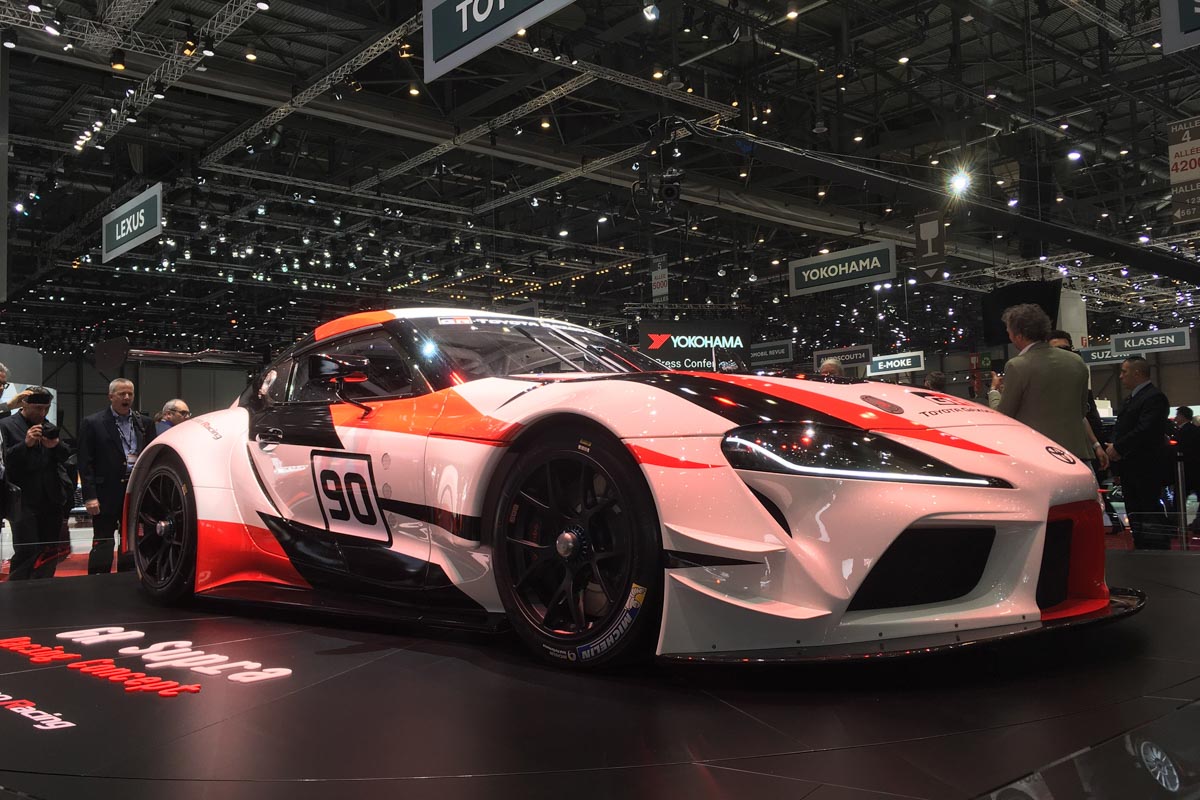“The legend returns”, says Toyota, and given the growth in stature of the Supra name since its demise 16 years ago, it’s hard to argue with that. The fifth generation Supra is undoubtedly one of the most keenly awaited new car debuts, and at Geneva Toyota has teased us once again with its clearest indication yet of what a finished production car might look like.
However, as we reported last month, leaked information in Japan suggests the road car will have a six cylinder engine producing 335bhp and 332lb ft of torque, with 0-100kph dispatched in 3.8-seconds. A weight figure of 1,496kg has been rumoured, but is not substantiated.

What Toyota has said is that the front and rear bumpers, front splitter and diffuser, side skirts, mirror housings, rear wing and bonnet are all made from composite material on the Racing Concept, and that the windscreen and side windows are plastic, not glass. The wheels are BBS centre lock racing wheels shod with Michelin ‘racing tyres’, and the suspension is lowered but of O.E. design. Braking is via a set of Brembo motorsport discs and calipers, with a race-spec exhaust and an interior fully equipped for modern motor racing, with OMP bucket seat, roll cage and sophisticated steering wheel with its own display and numerous switches.
Toyota FT-1 concept car
Our biggest clue to what the new Supra might look like has been the FT-1 concept car that made its debut at the 2014 Detroit motor show. The camouflaged test car showed a profile and strong central nose similar to that of the FT-1.
Toyota calls the FT-1 ‘a symbol that captures elements of the emotion and energy’ of future products. Originally penned by CALTY Design Research, Toyota’s California-based American design team, who took their influence from classic Toyota sports cars like the 2000GT and Celica.
The latest images show the FT-1 painted in graphite metallic paintwork rather than the red hue seen on the original concept, the CALTY team also transformed the interior. The previous red and black theme has made way for saddle tan leather, giving the cabin a more ‘sophisticated’ feel.

Toyota says its designers drew inspiration from modern superhero films for the FT-1’s cockpit, drawing on the use of high-tech materials rather than the bright, garish colours of comic book characters. To this end, CALTY went as far as comparing leather thicknesses, grain size and textures to find the perfect combination for the FT-1’s simple, driver-focused cabin.
Seats are punctuated with a raised metal mesh for both ventilation and texture, and Toyota touts the 3D, technical look of the instrument panel’s embossed graphic finish.
‘We wanted the driver to have a feeling of flow while at the wheel – to be able to focus on the road and nothing else,’ explains Selene Lee, a CALTY designer. ‘Our aim was to ensure everything supported the driver through efficient choices’ Lee adds, noting the new colour choices have the same ‘in the zone’ feel as before, with a greater premium air.
The Toyota Supra prototype
The new Toyota Supra is set to arrive in 2018, shortly after BMW launches its Z4 sibling. Will the Toyota-BMW partnership (named the Silk Road Project because of its East-meets-West approach) bear fruit? It’s not the first time the brands have worked together, having shared diesel engine tech across the Toyota, BMW and MINI brands for several years as well as collaborating on hydrogen fuel cell tech. We look forward to seeing if the Silk Road Project can produce a convincing successor to the iconic Supra.
This article originally appeared at evo.co.uk
Copyright © evo UK, Dennis Publishing

